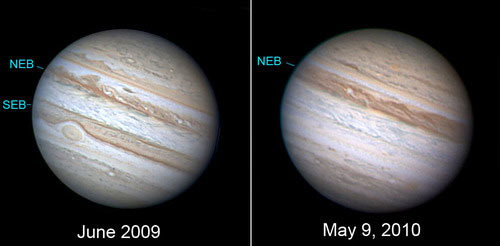Jupiter Has Lost a Cloud Stripe, New Photos Reveal

Thisstory was updated at 8:10 a.m. ET.
A giant cloud belt in the southern half of Jupiter has apparently disappearedaccording to new photos of the planet taken by amateur astronomers.
ThenewJupiter photos, taken May 9 by Australian astronomer Anthony Wesley, revealthat the huge reddish band of clouds that make up the planet's SouthernEquatorial Belt has faded from view.
Jupiter'strademark Great Red Spot, a massive storm that could fit two Earths inside, istypically found along the edges of the planet's Southern Equatorial Belt (SEB).?When the southern cloud belt fades from view, the Great Red Spot stands outalong with Jupiter's Northern Equatorial Belt of clouds in telescope views.
"Itwas evident to Jupiterwatchers late last year that the planet was going into one of these SEB fadingcycles, but then it was lost behind the sun for several months and naturally everyone who follows these things was eager to take images as soon as possible after its re-emergence in March,"Wesley told SPACE.com in an e-mail.
"Asit moves away from the sun (from our point of view) it will be possible tocapture even better images and perhaps we will be watching later this year ornext year when the SEB revival takes place. The timing of this revival is notknown, but historically this is a very dynamic event with planet-wide outbreaksof violent storms around the SEB latitude and eventually clearing away theobscuring clouds to reveal the dark SEB once more," he added.
Wesley'sphotos were also released by The Planetary Society in California, which addedthat Jupiter's Southern Equatorial Belt tends to fade from view about everythree to 15 years.
"Jupiterwith only one belt is almost like seeing Saturn when its rings are edge-on andinvisible for a time -- it just doesn't look right," wrote skywatcher BobKing of Duluth, Minn., in a May 10 entry of his blog "Astro Bob"while discussing Wesleyan's surprising Jupiter views.
Breaking space news, the latest updates on rocket launches, skywatching events and more!
Jupiteris currently shiningvery bright in the eastern sky before sunrise.
Wesleyis a veteran Jupiter watcher and posted the new shots on his website. It was hewho first spotted a dark blemish on the planet in July 2009 that pointed to an impacton Jupiter, most likely from a comet. Wesley also spotted a giant blizzardon Saturn that is currently raging.
"Jupiteris a joy to observe and image, its dynamic atmosphere and brightly coloredclouds mean that every view is different to the last even from one day to thenext, and driven by the internal heat from deep inside the atmosphere you canbe sure there is always something violent and interesting going on,"Wesley said.
Changesin Jupiter's weather are not uncommon.
Lastyear, astronomers announced that Jupiter's Great Red Spot ? which has raged forat least 300 years ? appeared to be shrinking. In 2008, other redspot-like storms (smaller than Great Red) showed changes as well, whileactivity in the Southern Equatorial Belt also appeared to slow down.
Jupiteris the largest planet in our solar system and no stranger to weird weather.
Earlierthis year, astronomers announced that the gas giant likely has helium rainshowers from time to time. Jupiter has also tended to grow a variety of newstorms, or spots, with some even changing color between white and red duringdramatic climate changes on the gas giant.
- Gallery - Jupiter Gets Slammed by a Comet
- The Wildest Weather in the Galaxy
- Images - Jupiter and its Many Moons

Tariq is the award-winning Editor-in-Chief of Space.com and joined the team in 2001. He covers human spaceflight, as well as skywatching and entertainment. He became Space.com's Editor-in-Chief in 2019. Before joining Space.com, Tariq was a staff reporter for The Los Angeles Times covering education and city beats in La Habra, Fullerton and Huntington Beach. He's a recipient of the 2022 Harry Kolcum Award for excellence in space reporting and the 2025 Space Pioneer Award from the National Space Society. He is an Eagle Scout and Space Camp alum with journalism degrees from the USC and NYU. You can find Tariq at Space.com and as the co-host to the This Week In Space podcast on the TWiT network. To see his latest project, you can follow Tariq on Twitter @tariqjmalik.
